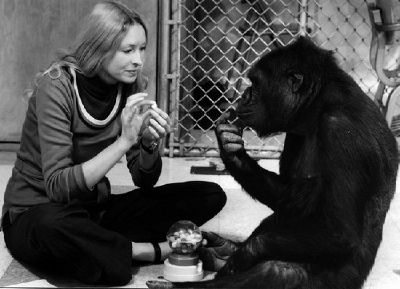GMU:DIY Biolab “Driver’s License”/Interspecies communication: Difference between revisions
| Line 11: | Line 11: | ||
* Francine "Penny" Patterson, PhD, started working with Koko, a lowland gorilla, in 1975. http://d2rights.blogspot.de/2012/09/koko-talking-gorilla-1978.html | * Francine "Penny" Patterson, PhD, started working with Koko, a lowland gorilla, in 1975. http://d2rights.blogspot.de/2012/09/koko-talking-gorilla-1978.html | ||
* Lisa Jevbratt (2009) Interspecies Collaboration – Making Art Together with Nonhuman Animals, http://jevbratt.com/writing/jevbratt_interspecies_collaboration.pdf | * Lisa Jevbratt (2009) Interspecies Collaboration – Making Art Together with Nonhuman Animals, http://jevbratt.com/writing/jevbratt_interspecies_collaboration.pdf | ||
[[File:550_patterson.jpg|400px|Penny with Koko. Source: http://d2rights.blogspot.de/2012/09/koko-talking-gorilla-1978.html]] | |||
===Parasitic communication=== | ===Parasitic communication=== | ||
Revision as of 15:51, 13 December 2017
Interspecies communication
Evolutionary theory of Lynn Margulis (formerly Sagan)
Being an evolutionary theorist, Lynn Margulis criticized the traditionally accepted theory of evolution proposed by Charles Darwin; she introduced evolution as merely collaborative interaction rather than the struggle for existence. If the struggle for existence in Darwin's theory led to natural selection and survival of the fittest (Darwin, 1859), Margulis introduced a theory of symbiotic organisms wherein, through interaction and collaboration, prokaryotic organisms evolved into more complex eukaryotic cells (Sagan, 1966). In her article "On the Origin of Mitosing Cells,” the theory is introduced through the interaction of three ancient organelles: the mitochondria, the photosynthetic plastids, and the flagella, which, over the course of changing weather conditions in Earth's history, were impelled to mutate into one organism. This process was possible due to vapor and the escape of free hydrogen into the upper atmosphere, which led to the production of molecular oxygen. The increasing amount of oxygen, in turn, was consumed by other organisms that had to survive in the changing conditions: An aerobic prokaryotic mitochondrion was ingested into the cytoplasm of a heterotrophic anaerobe, while symbiotic cilium attached to other bacteria and formed a flagellum. Further evolution resulted in eukaryotic blue-green algae:
“During the course of the evolution of mitosis, photosynthetic plastids (themselves derived from prokaryotes) were symbiotically acquired by some of these protozoans to form the eukaryotic algae and the green plants” (Margulis, 1966:225).
The idea of evolutionary change via interacting organisms suggests that we humans are not humans because we “think,” but because we interact with other organisms and we evolve with other organisms.
Cooperative communication
Or interspecies collaboration.
- Francine "Penny" Patterson, PhD, started working with Koko, a lowland gorilla, in 1975. http://d2rights.blogspot.de/2012/09/koko-talking-gorilla-1978.html
- Lisa Jevbratt (2009) Interspecies Collaboration – Making Art Together with Nonhuman Animals, http://jevbratt.com/writing/jevbratt_interspecies_collaboration.pdf
Parasitic communication
Blue and great tits compete for resources such as food and nesting cavities by for example blue tits imitating great tits
Experiment
pheromones
A pheromone (from Ancient Greek φέρω phero "to bear" and hormone, from Ancient Greek ὁρμή "impetus") is a secreted or excreted chemical factor that triggers a social response in members of the same species. Pheromones are chemicals capable of acting outside the body of the secreting individual to impact the behavior of the receiving individuals.(https://en.wikipedia.org/wiki/Pheromone)
- alarm pheromones
- food trail pheromones
- sex pheromones
Fruit flies
Also /Drosophila melanogaster/. Drosophila is typically used in research because it can be readily reared in the laboratory. It is one of the most widely used and genetically best-known of all eukaryotic organisms.
Drosophila breeds quickly, and lays many eggs. It is a common pest in homes, restaurants, and other places where food is served. The lifespan of Drosophila is about 30 days at 29 °C. The shortest development time (egg to adult), 7 days, is achieved at 28 °C. With decreased or increased temperature the development time increases. Females lay some 400 eggs (embryos), about five at a time, into rotting fruit or other suitable material such as decaying mushrooms. The eggs, which are about 0.5 mm long, hatch after 12–15 hours at 25 °C.
Medium
http://www.anapsid.org/fruitfly.html
RECIPE #1 Anthony Hundt (an old recipe of mine)
- 8 bananas
- 1/4 cup sugar
- rolled oats (oatmeal)
- 1 packet bakers yeast
Put banana and sugar in blender and mix until the banana is liquified. Mix in oatmeal until it becomes firm, but still moist. Put mixture in wide mouth quart canning jars. Add a few granules of bakers yeast to the surface and add about 30 fruit flies. Cap the jars with a paper towel folded in fourths held on with a rubber band. Substitution with other types of fruit also works.
References
- Lisa Jevbratt (2009) Interspecies Collaboration – Making Art Together with Nonhuman Animals, http://jevbratt.com/writing/jevbratt_interspecies_collaboration.pdf
